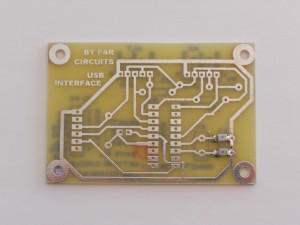Credit for this version of the circuit goes to Jimbo Harris.
The serial version of the DSC circuit described in these pages is readily adapted to use with a USB-serial conversion cable. In fact, FTDI makes the TTL-232R-5V cable that converts TTL-level serial data coming straight from the PIC into USB for the PC.

Using this cable allows us to eliminate the MAX232 chip (and several capacitors) used in the serial circuit that converts TTL to RS-232 and back. At also allows us to eliminate the external power supply and the components making up the voltage regulator for the board. Instead, we draw power from the USB port itself.
Here’s the schematic for the USB version of the DSC board:
While updating the original circuit for USB, it made sense to make a couple of other changes. Most noticeable is the elimination of the pull-up resistors on the unused PIC I/O pins. Less obvious is the change from the four-pin oscillator to a simple crystal for clocking the PIC. Finally, the original PIC16F84 was replaced by an equivalent but cheaper part, the PIC16F628 (requiring updated hex code). And, of course, there’s no longer a DB9 connector on the board for a serial port. Instead, 6-pin connector JP4 is the connection point for the TTL-232R-5V cable. The result is that the USB version of the circuit is considerably simpler than the serial version.
FAR Circuits sells a kit for this circuit that includes a PC board and all board-mounted parts and connectors, but not the TTL-232R-5V cable. You’ll need to purchase the TTL-232R-5V cable separately. Both Mouser and DigiKey sell this cable for about $20 plus shipping. Go here for information on how to order the kit from FAR Circuits.
Note that the FAR Circuits board comes with capacitors C1 and C2 as chip capacitors pre-soldered on the bottom of the board.
Construction of the circuit is pretty straightforward. Basically, solder the parts in whatever order you wish. I recommend buying a socket for the PIC chip, but it’s not mandatory. Just make sure that the PIC is installed in the proper orientation. The PIC has a little dimple next to pin 1, or a semicircular cutout on the end of the chip closest to pin 1. If you hold the chip vertically with the cutout at the top, pin 1 will be the top left pin. The hole for pin 1 on the board is labeled “1”.
The TTL-232R-5V cable must be connected in the proper orientation, too. Just make sure that the colors of the wires on the connector coincide with the colors labeled on the board and you’ll be good to go.
Once the circuit is constructed and the TTL-232R-5V cable is connected, plug it into your PC and see if it’s recognized as a COM port. You may need to install the FTDI VCP driver for the cable in order for it to be recognized by your OS. Drivers are available for Windows, Mac, and Linux. Installation instructions for the drivers can be found here. Make sure to note the COM port number of the cable once it’s recognized. That’s the COM port you’ll need to enter into any astronomy software that you plan to use with the circuit.
There are testing and troubleshooting instructions on the “Building the Circuit” page for the serial version of the DSC board that can be used for the USB version, too.





